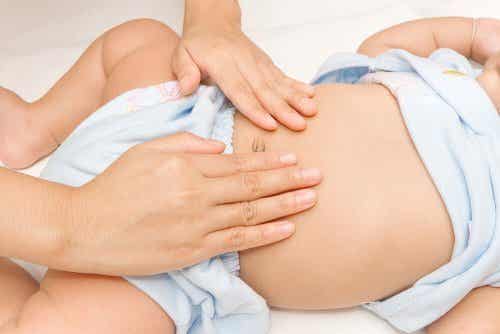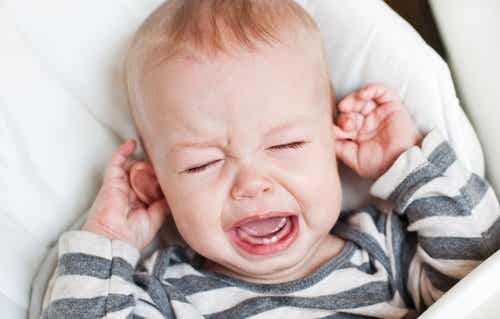Intussusception in Babies: What Is It?

Intussusception is the most common cause of intestinal obstruction in babies. It can become a serious illness in some cases, so it’s important to know how to detect and treat it in time. Here we tell you everything you need to know about intussusception in babies.
What is intussusception?
Intussusception is an obstruction, that is, a blockage that doesn’t allow the passage of food or liquids through the small or large intestines. In this case, the obstruction occurs because one piece of the intestine slips into another.
When this happens, the area that supplies blood and oxygen to that part of the intestine is compressed. If not treated quickly, it can lead to inflammation, bleeding, and the death of that part of the intestine and may need to be removed.

Who does intussusception affect?
This condition usually presents between three months and six years of age. It has a peak incidence between four and twelve months, that is, in babies who don’t yet know how to express what’s happening to them, which makes it an even more complicated situation. It rarely affects infants under one month of age. Finally, this disease tends to affect boys more often than girls.
What are the symptoms of intussusception in babies?
Normally, intussusception causes a sudden, very intense abdominal pain, as if the baby has colic. The baby becomes tearful and irritable. A very common sign is that the baby curls up its legs to relieve the pain. In addition, the baby may become pale.
This colicky pain comes and goes, then returns after 15 to 20 minutes. During these pain-free intervals, the infant often appears listless and exhausted. At the beginning of the clinical picture, the infant may vomit the last food they’ve eaten.
A characteristic sign of intussusception is what is known as red currant jelly stool, as the baby may poop red blood and mucus. If the obstruction is left untreated, the child may develop a high fever, difficulty breathing, or a weak pulse. This is a serious situation that requires emergency treatment.
You may be interested in: Digestive Illnesses in Children: What You Should Know
The diagnosis of intussusception in babies
A doctor will diagnose this pathology based on the clinical presentation of the child and by performing a physical examination. They may also need to perform some imaging tests, such as an ultrasound or a simple X-ray.

On the other hand, in more advanced or more serious cases, the child will be operated on directly. We must remember that if intussusception isn’t treated in time, it can become a very serious and even fatal condition.
You may be interested in: What’s a Fecal Transplant and When Is it Recommended?
Regarding intussusception, you should know…
As we’ve already mentioned, this is a frequent condition in babies between four and twelve months old, which makes it more complicated, since they still can’t tell us what hurts them and they’ll simply be tearful and irritable.
Therefore, the most important thing, as always, is that, in case of any sign that alerts us in our baby, we go to the specialist as soon as possible. The professional will be the one to decide which tests are necessary to reach a diagnosis and to establish the most appropriate treatment.
Intussusception is the most common cause of intestinal obstruction in babies. It can become a serious illness in some cases, so it’s important to know how to detect and treat it in time. Here we tell you everything you need to know about intussusception in babies.
What is intussusception?
Intussusception is an obstruction, that is, a blockage that doesn’t allow the passage of food or liquids through the small or large intestines. In this case, the obstruction occurs because one piece of the intestine slips into another.
When this happens, the area that supplies blood and oxygen to that part of the intestine is compressed. If not treated quickly, it can lead to inflammation, bleeding, and the death of that part of the intestine and may need to be removed.

Who does intussusception affect?
This condition usually presents between three months and six years of age. It has a peak incidence between four and twelve months, that is, in babies who don’t yet know how to express what’s happening to them, which makes it an even more complicated situation. It rarely affects infants under one month of age. Finally, this disease tends to affect boys more often than girls.
What are the symptoms of intussusception in babies?
Normally, intussusception causes a sudden, very intense abdominal pain, as if the baby has colic. The baby becomes tearful and irritable. A very common sign is that the baby curls up its legs to relieve the pain. In addition, the baby may become pale.
This colicky pain comes and goes, then returns after 15 to 20 minutes. During these pain-free intervals, the infant often appears listless and exhausted. At the beginning of the clinical picture, the infant may vomit the last food they’ve eaten.
A characteristic sign of intussusception is what is known as red currant jelly stool, as the baby may poop red blood and mucus. If the obstruction is left untreated, the child may develop a high fever, difficulty breathing, or a weak pulse. This is a serious situation that requires emergency treatment.
You may be interested in: Digestive Illnesses in Children: What You Should Know
The diagnosis of intussusception in babies
A doctor will diagnose this pathology based on the clinical presentation of the child and by performing a physical examination. They may also need to perform some imaging tests, such as an ultrasound or a simple X-ray.

On the other hand, in more advanced or more serious cases, the child will be operated on directly. We must remember that if intussusception isn’t treated in time, it can become a very serious and even fatal condition.
You may be interested in: What’s a Fecal Transplant and When Is it Recommended?
Regarding intussusception, you should know…
As we’ve already mentioned, this is a frequent condition in babies between four and twelve months old, which makes it more complicated, since they still can’t tell us what hurts them and they’ll simply be tearful and irritable.
Therefore, the most important thing, as always, is that, in case of any sign that alerts us in our baby, we go to the specialist as soon as possible. The professional will be the one to decide which tests are necessary to reach a diagnosis and to establish the most appropriate treatment.
All cited sources were thoroughly reviewed by our team to ensure their quality, reliability, currency, and validity. The bibliography of this article was considered reliable and of academic or scientific accuracy.
- Domínguez-Carral J, Puertas-Martín V, Carreras-Sáez I, Maraña-Pérez AI, Escobar-Delgado T, García-Peñas JJ. (2014). Neurological symptoms in children with intussusception. An Pediatr. 2014 May 1;80(5):293–8.
- Lucero A Y, Valenzuela B MT, O’Ryan G M. (2004). Perfil epidemiológico y clínico de la invaginación intestinal en lactantes de la Región Metropolitana. Rev Med Chil. 2004 May;132(5):565–72.
- Jiménez Felipe JH. (2005). Invaginacion intestinal en pediatria. Vol. 12, Revista Mexicana de Cirugía Pediátrica.
This text is provided for informational purposes only and does not replace consultation with a professional. If in doubt, consult your specialist.








